The pain, fear and grief of the past few weeks have been overwhelming. I may not live in the United States anymore, but I am a citizen and I am heartbroken and furious about what is happening in my country. I dance between staying as informed as I can and feeling overwhelmed by the helplessness and the overload of terrible news. I am heartened by the fact that only 22% of the population voted for the man in office and by the actions of brave civil servants and judges and activists and attorneys who are fighting tooth and nail to save what they can. I ache for all the suffering already unleashed and what is still to come.
Something I think about often is a line from Frank-Walter Steinmeier’s speech on the 75th anniversary of the end of the Second World War:
“Germany’s past is a fractured past – with responsibility for the murdering of millions and the suffering of millions. That breaks our hearts to this day. And that is why I say that this country can only be loved with a broken heart.”
When I heard him say that, I cried. For the first time, someone - a German - was able to articulate the complicated feelings I have for this country, the one I was born in and the one I chose to live in again. The one that often disappoints and angers me, the one that is my home, for better or for worse, the one that I do, in some funny way, love. When I hear the swelling notes of Haydn’s Kaiserquartett, which later became the German national anthem, they move me deeply. Not because of what the hymn represents, no, but because the music’s beauty, its delicacy and harmony, stands in such stark contrast to the incomprehensible crimes the country it now embodies once committed.
An age-old question, here and abroad, is how this country, the one of poets and thinkers, the place of such profound artistic, scientific and philosophical achievements, could have committed such atrocities. It is not hard, in recent weeks, to think back on this question, reflect on what is happening in the United States and draw parallels. Not all Germans voted for the Nazis. In fact, in 1930, only about 18% of the electorate voted for the party. But over time, through fear and coercion and propaganda and anti-Semitism and by weaponizing prejudice, the party reigned supreme. Mass murder didn’t come until much later, just like the global effort to stop it. Too late for many millions of people.
But Steinmeier’s words also made me cry because, as an American, I feel the same way about my country. America, built on the mass displacement and extermination of Native people and by the enslavement and subjugation of many generations of Black people. America, land of opportunity and hardship. Land of a million kindnesses and hypocrisy and cruelty. Land of the free and brave and unjust and unfair. Land of innovation and marvelous horizons, of literature and music and culture. Land of prejudice and discrimination, violence and sacrifice. To love America, for me, is to love it with a broken heart. Now more than ever.
+++
Something I find particularly challenging in moments like this is to continue business as usual. I feel paralyzed and insignificant and also struck somewhat mute by overwhelm. But the longer I stay quiet, the harder it feels to start again. And of course life goes on. So please forgive this slightly awkward segue. I’d like to tell you about my trip last week to Trieste, an experience that filled my cup a little. I hope it’s useful.
Last week, I went to Trieste with my pal Joe. It was the boys’ annual winter break and Max took them to Austria to ski, so I was on my own - hallelujah! Neither Joe nor I had ever been to Trieste and there were cheap direct flights from Berlin to be had, so we pounced. We stayed at the Hilton Doubletree (for €110/night!), which was in a beautiful historic building in the center of the city. (If you stay there, make sure to have an aperitivo in the building’s bar that is in a spectacular room on the first floor. It has an intricately coffered wood ceiling, stunning wall mosaics and other lovely period details.) We were in Trieste for five days, which was enough to really explore the city thoroughly and still have plenty of downtime. You could squeeze the whole thing into three days, if you wanted to, but we were happy to have time to decompress every day.
Trieste is located just a few kilometers from the Slovenian border and is very close to Croatia too. The influence of the Austro-Hungarian empire is everywhere, from the architecture to the food to the clean and tidy appearance of its streets. My copy of Jan Morris’ Trieste and the Meaning of Nowhere didn’t arrive in time for me to read before our trip, but I can’t wait to dig in as soon as I finish her book on Venice, which I think you should read instead of traveling to Venice, but more on that another time. Trieste in February was wonderful: quite empty, but with beautiful weather, blinding sunshine and blue skies every day. We even got to experience the famous bora wind.
We started our trip by visiting the city’s free Joyce Museum. James Joyce lived in Trieste for many years and wrote Ulysses there. (I first read it in college, while on spring break in Acapulco at my friend’s grandfather’s beachfront apartment, talk about cognitive dissonance!) It was fascinating to understand just how important Trieste was to Joyce and what a central role it played in his literature. The museum even has letters he wrote in Triestine dialect on display.
The tourism office on Piazza Unità had a €5 audio tour of the city that we could download onto our phones. It was interesting and better than I expected! The tour was about 2 hours long and we could go at our own pace. We ended up seeing more things than we would have otherwise and getting a deeper understanding of many sights.
We went to a retrospective of Steve McCurry’s work at the city’s beautifully named Salone degli Incanti exhibition space. The photographs were illuminated in a completely dark hall and the faces and places glowed out at us. It was magical. The works on display stretched back to the early 1980’s.
We took the bus to the enchanting Miramare Castle, about half an hour north of the city, which was built by the Austrian Archduke Maximilian Ferdinand and his wife (they later became Emperor and Empress of Mexico for a variety of bonkers reasons and later still, the widowed Charlotte died a madwoman). The castle is set on Italy’s first marine reserve and the water is crystal clear. The castle is like a smaller Sanssouci by the water, with elegantly laid out gardens. A delight.
We also visited the Museo Revoltella, which was bequeathed to the city by its owner Pasquale Revoltella. Part of the museum was closed when we visited, but it was still an astonishing look into the home of a wealthy Triestine, one of the first shareholders of Assicurazioni Generali (which was founded in Trieste). I was particularly taken with the portraits by Giuseppe Tominz, especially this one.
Finally, we couldn’t resist buying tickets to an opera performance at the Teatro Verdi, even if it was just in the small sala. It wasn’t anything special, but for some reason going to performances on vacation always seems like a really intimate way to experience a place. Do you know what I mean?
The only thing I regret was not making the trek to Redipuglia. My great-grandfather Salvatore Silvestris was killed in the first few weeks after Italy entered World War I and he is buried there. This is the same great-grandfather who, a decade earlier, emigrated to New York, where my grandmother was born in a Brooklyn tenement. After the death of another child, the family returned to Italy. Salvatore’s widow, my mother’s Nonna Angelina, was only 35 and pregnant with their fifth child when he died. She lived to be 102 and has mythic status in our family. In some parallel universe, Salvatore and Angelina stayed in Brooklyn and he didn’t die in the war and they raised their children there and my grandmother grew up as an American and my mother wasn’t born and and and…
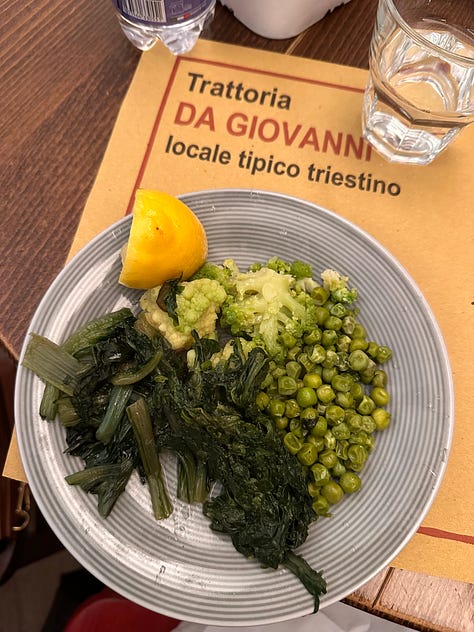
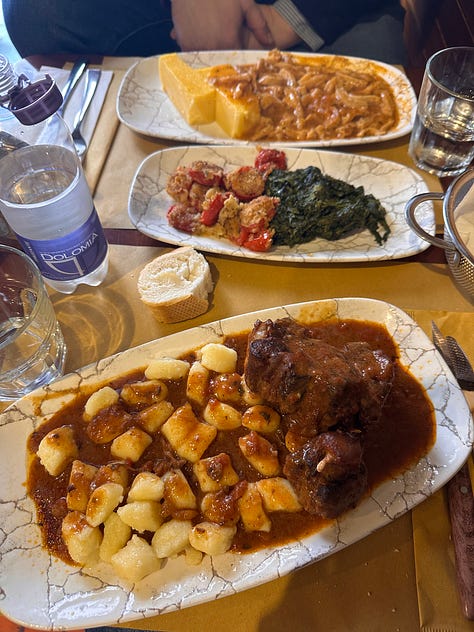
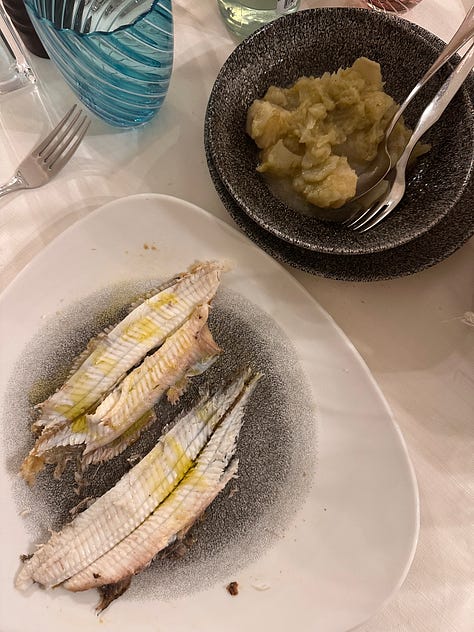
We had scarcely one bad meal in Trieste, which felt like a small miracle after Venice. On our first day, we stopped into a shoe store so I could try on some Friulane, but then we started chatting with the owners and soon they were listing all the places we had to try. So most of this list is thanks to them!
Trieste’s most traditional restaurants are called buffets. They are quite rustic, some are standing room only. There are a variety of dishes of the day, but you can also simply order a plate of sliced cooked ham with grated horseradish (Triestines call it Kren, like the Austrians) and Sauerkraut. Or little crostini with whipped salt cod - baccalà mantecato. The Venetian custom of cicchetti, little crostini topped with a variety of salumi or fish, is widespread in Trieste.
The buffets we tried and loved at lunchtime were da Giovanni and l’Approdo (still thinking about the gnocchi with oxtail I had there). We had absolutely fantastic Neapolitan-style pizza at Bianco. (Also Joe would like me to mention that the eggplant Parmigiana there was really good, too.) We went bar-hopping one night and especially liked Al Ciketo. It was very busy, but we still found room and were served right away. All in all, so refreshing after the madness and frustration of restaurants in Venice! We had a delicious dinner at Menarosti where the cooking was simple but wonderful in the particular way that Italian restaurant cooking can be and the menu featured lots of local fish.
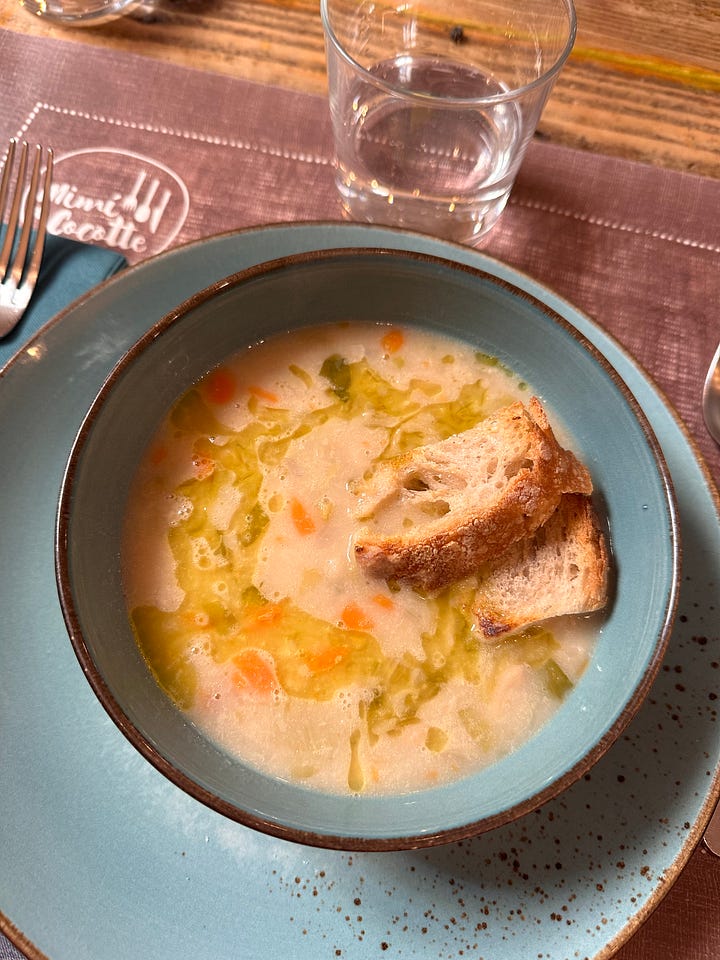
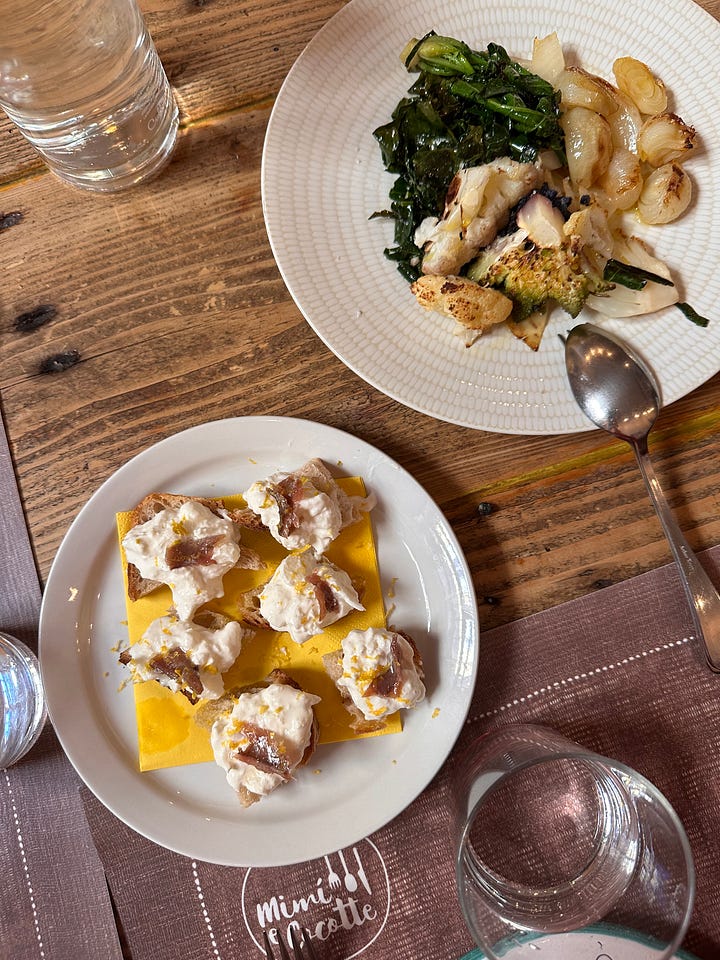
But I think my favorite meal in Trieste was actually lunch at a place called Mimi e Cocotte, which was recommended to me by someone on Instagram (thank you!). We had little crostini of stracciatella topped with anchovies and lemon zest, a perfect bowl of bean soup, and the most wonderful plate of vegetables. Everything was perfectly seasoned and absolutely delicious. Such a great place.
Every day after lunch, we had a marocchino at a variety of different bars. A marocchino is served in a tiny glass and consists of a layer of hot chocolate or melted chocolate, a shot of espresso and a little pour of steamed milk. At the Antica Tostatura Triestina, a wood-fired coffee roastery, the chocolate was replaced with a chocolate hazelnut mixture. Excellent.
Trieste has an Eataly, which was great for souvenir shopping (I came home with five different bags of pasta and a sackful of dried cherry tomatoes). Its location, right on the water next to the Salone degli Incanti, was fantastic. Our Friulane friends told us it’s an excellent place for an aperitivo as you can watch the sunset out of the big picture windows.

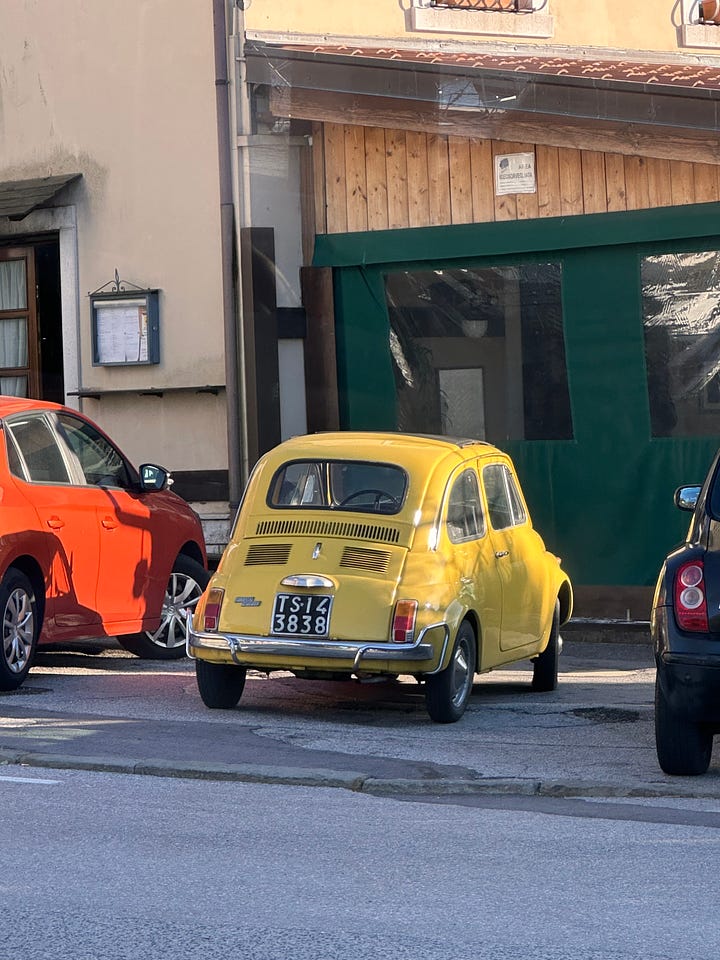
All in all, it was a wonderful week with one of my best pals. My boys, just over the mountains that divide Austria and Italy, had a great time too. And we were all so happy to see each other again! I highly recommend taking trips separately from your family now and again. I’m already scheming for next year…
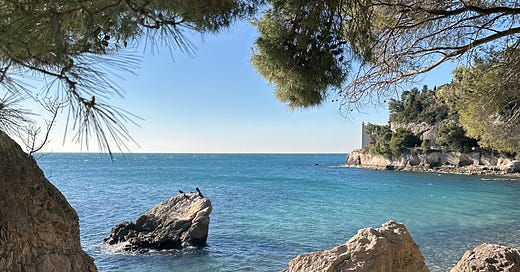


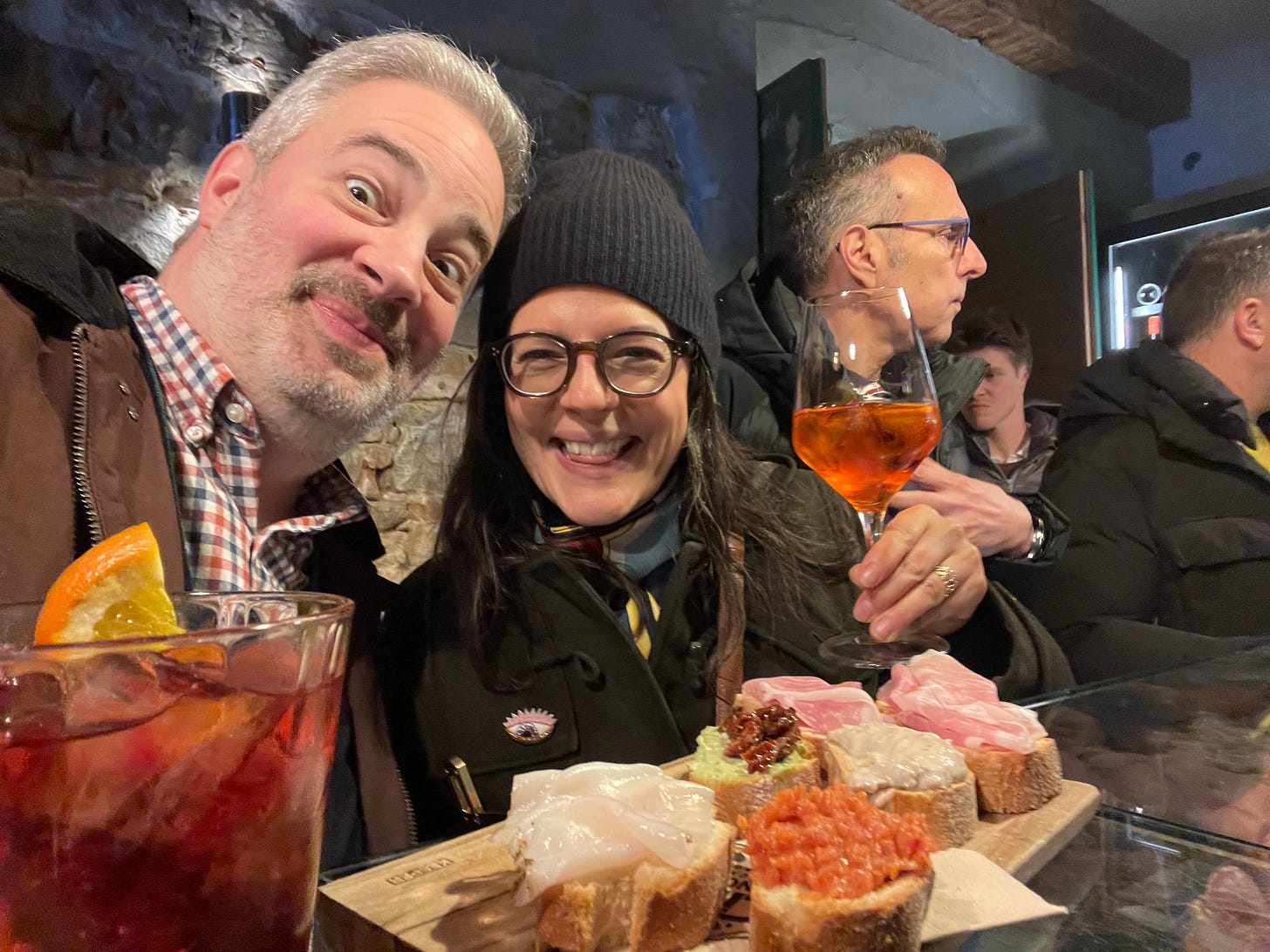
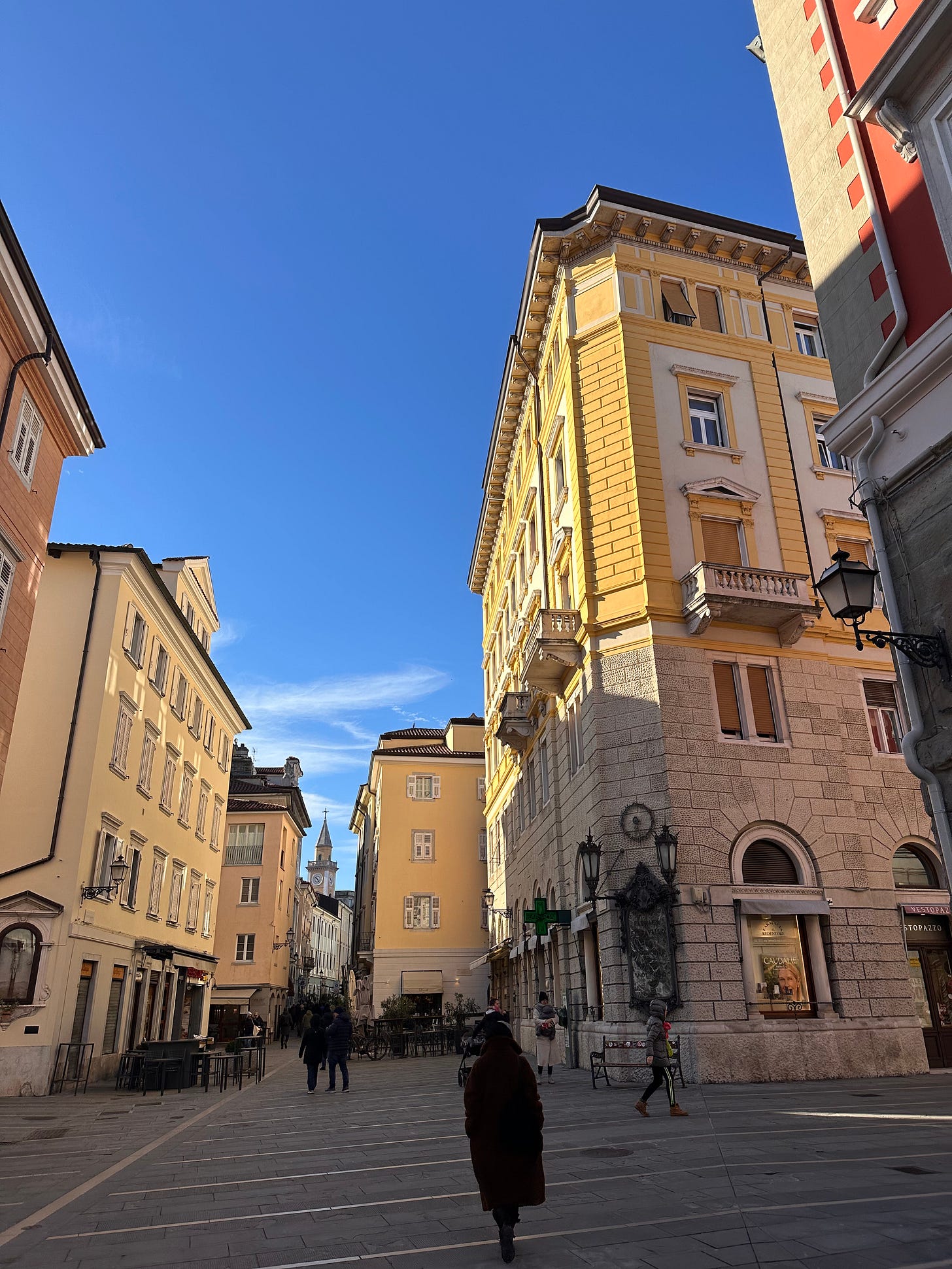


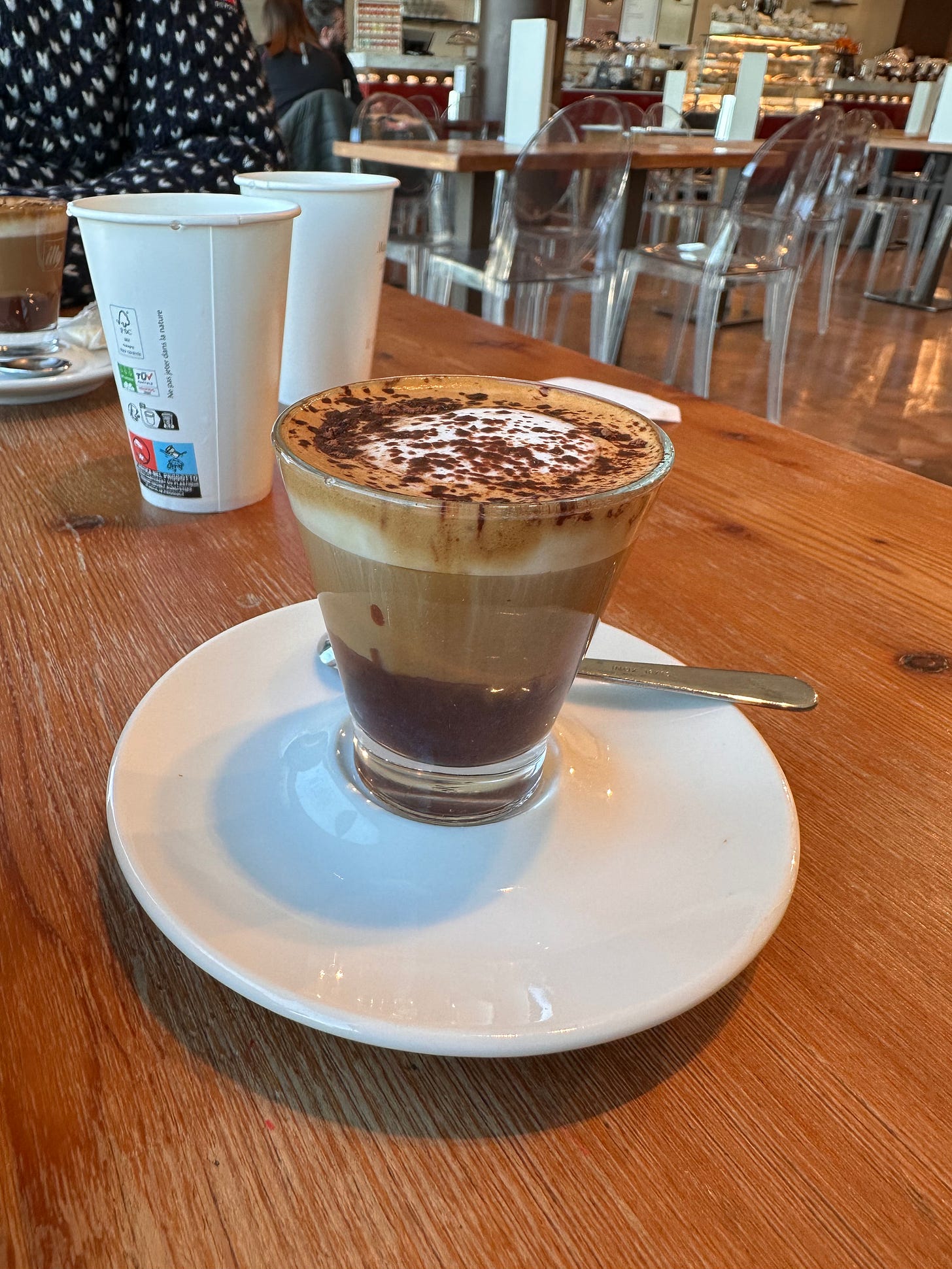
Thank you so, so much for your thoughts on what is happening here in the U.S. You captured my feelings so well.
And as for the segue, now I want to catch the next plane (or probably many planes) to Trieste!
Thank you for this Luisa, it brought me to tears - especially the part about loving a country with a broken heart. What are we to do?
We are in for a long season of awkward segues as this continuing nightmare unfolds. So far my intuition is telling me something counter intuitive: it is okay to feel good. That it's important, necessary even to do things that nourish our selves, our souls and our loved ones. So yay for this trip to Trieste.
A book that has answered my prayers is 'How to doNothing Resisting the Attention Economy'. by artist Jenny Odell. She wrote it after the 2016 election. The book has been a tonic to me and illustrates how reclaiming ones attention is an act of resistance. It's the first step that gives you the space and equilibrium to figure out what to do next. Anyway, perhaps you or others here will find it helpful.